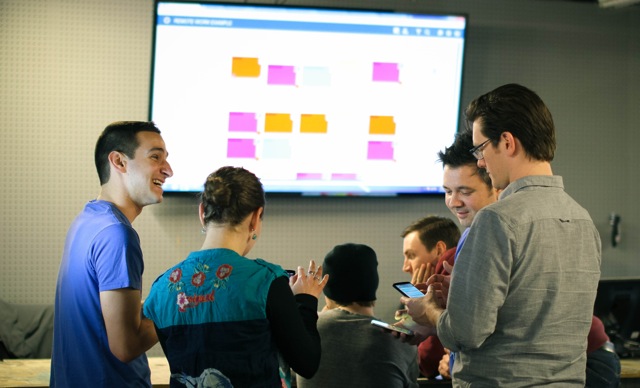
There is a lot of guidance in the world about hosting retrospectives in person, but not as much about leading remote retrospectives. As a product manager of a Lean/Agile product, I’ve participated in and led my fair share of retrospectives, both remotely and in person.
Retrospectives can be an incredibly helpful tool, giving teams an opportunity to bond, learn, and grow together. But as anyone who has participated in a less-than-productive retrospective can attest, not all retrospectives are created equal.
Engaging in a healthy, open discussion about what went well, what didn’t, and how to improve next time, can be tricky. Doing it remotely (as many teams have learned in the past year) adds another layer of challenges.
A Retro on the Retros I’ve Led
Although the world is slowly starting to open back up, it’s likely that a larger percentage of your coworkers will be working remotely than before the pandemic. Or perhaps your team has always been distributed and has never quite figured out how to successfully run a remote retrospective.
As a full-time remote employee, the majority of my experience leading and participating in retrospectives has been remote — so I thought I’d share some of the things I’ve learned participating in and facilitating remote retrospectives meetings: A retrospective on retrospectives, if you will. I’ll also share about a pretty awesome tool we’ve been working on designed specifically to help teams facilitate collaborative discussions remotely.
What Went Well
I find it’s always helpful to start retrospectives on a positive note. So first, here are some tips I’ve learned that help to ensure a successful retrospective.
Tip #1: Make sure you get the right people “in the room”
Perhaps the most important element to ensuring that your retrospective is successful (and by that I mean, that everyone feels like it was a productive use of time) is to have the right people in the room. (Of course, we’re talking about remote retrospectives here, so the room I’m referring to is a virtual space, not a physical one.)
Anyone who participated in, was affected by, or contributed to an event should be invited to the retrospective about that event. In order to truly understand what happened, what went well, what didn’t, etc., you need to gain the perspectives of everyone involved.
Read next: 3 Questions to Ask During Standup to Keep Speed a Priority
Tip #2: Allow participants to invite others
This tip is related to the first one, but worth calling out: When you create the calendar invite for the retrospective, make sure to select the option that allows participants to invite others to the meeting. Let participants know that they are free to invite anyone who might want to participate.
Tip #3: Make sure everyone knows what the retro is about
It might seem obvious, but make sure that everyone attending your remote retrospective is aware of exactly what is being discussed, and why.
Instead of just slapping an event called “Retrospective” on everyone’s calendars, get specific with the title, i.e. “Retrospective on X Feature Launch.” Then add a description to the invite as well, detailing the purpose of the retrospective, and encouraging participants to invite anyone to the meeting who might want to contribute.
Tip #4: Find the right facilitator
Facilitating a successful remote retrospective requires the right person for the job. In some cases, that might be the person who cares the most about the topic at hand, or just the person who is best at facilitating conversations on your team.
In other cases, such as if the event was particularly tumultuous and there were a lot of feelings involved, it can be helpful to bring in an unbiased party to facilitate the discussion. In these instances, having someone from outside the situation can help to keep the conversation focused and civil.
Read next: How to Run Effective Standups and Retrospectives
Tip #5: Carefully strike a balance between ‘what went well’ with ‘what could be improved’
A good facilitator should encourage participation from everyone “in the room.” But first, they need to make sure that everyone feels comfortable participating. One thing I’ve found helpful is to start the meeting by reminding everyone of the purpose of the retrospective: To not only talk about what could be improved, but also to acknowledge and celebrate what went well.
Most retrospectives will lean heavily towards the ‘what could be improved’ discussions if left unchecked, so it’s important for the facilitator to actively work to also include a balanced amount of ‘what went well.’
Toward that end, it can be helpful to remind everyone that discussing what went well isn’t just about patting each other on the back. The purpose of using remote retrospectives to discuss what went well is to make sure that everyone keeps doing those things.
A good facilitator will continue to remind participants throughout the conversation that:
- The purpose of the retrospective is to encourage continuous improvement
- The purpose is not to assign blame to specific people or air out personal grievances
- The purpose is to identify both what to keep doing, where the opportunities to improve are, and which of those opportunities make sense focusing on now vs. accepting as a continued risk
Tip #6: Encourage shoutouts (acknowledge contributions to the project/event)
People love being acknowledged, and it also feels good to acknowledge others. This can be a great way to kick off a retrospective, especially a remote retrospective which can inherently feel a little more awkward.
By encouraging everyone to give ‘shoutouts’ to people for their contributions to the project/event being discussed, it can start the meeting on a positive note and get the conversation flowing.
Tip #7: Give everyone the power to unmute themselves!
Make sure that participants have the ability to mute or unmute themselves, and encourage them to stay unmuted (background noise permitting) so they can chime in naturally.
Tip #8: Acknowledge contributions to the discussion
I also find that acknowledging contributions to the discussion can go a long way in encouraging people to participate. It’s a small thing, but using people’s names can make the environment feel more intimate and encourage people to open up (especially important for remote retrospectives).
Here are some ways to acknowledge participants throughout the conversation:
- “Thank you ________, I know that wasn’t easy to share”
- “________, I’m sure that was difficult to hear.”
- “Thank you ________ for bringing that up”
- “I bet others have thoughts on that as well, thanks for getting that conversation started, ________.”
- “That’s a great point, does anyone have anything to add to what ________ said?”
Read next: Daily Kanban Standup: Is Your Team Ready for the Next Evolution?
Tip #9: Have the right tools for the job
Like with any other remote meeting, in order to hold remote retrospectives, you’ll need to have a video conferencing tool (Zoom, Microsoft Teams, Google Hangouts, etc.). But beyond that, you’ll want to have a way to keep everyone focused and aligned around the topics being discussed, as well as a way to document the ideas and action items that are being shared.
There aren’t many retrospective tools for remote teams out there, which is why we decided to create our own — more on that below!
What Didn’t Go Well
If I were to identify an overarching theme that makes retrospectives go poorly, it’s a lack of intentionality. Not having a clear objective. Not having the right facilitator. Not having the right people in the room. Not keeping the conversation focused on relevant topics. Letting one person talk the whole time. Leaving the conversation without agreeing on a few key takeaways or action items.
When run well, remote retrospectives will feel like organic, healthy team discussions. When run poorly, they will feel like a huge waste of everyone’s time.
Tip #10: Avoid these things
Here are some more specific things that I’ve found make it difficult to have a productive remote retrospective:
- Not including everyone who was involved in the event “in the room”
- Not having a facilitator or not having the right facilitator
- Holding the retrospective too long after the event occurred
- Letting people point fingers or assign blame
- Requiring the facilitator to “unmute” participants in order to contribute
- Not allowing enough time for a meaningful discussion
- Blocking off a long amount of time for the retrospective without building in breaks
- Trying to solve every problem that arises
- Focusing too much on what went wrong and not enough on what went well
Improvements I’ve Made
Through the years, I’ve always used Planview AgilePlaceTM as my preferred tool to facilitate retrospectives, both remotely and in person. Recently, our team decided to take some of the lessons we’ve learned using AgilePlace for retrospectives, to create a functionality specifically designed for holding collaborative conversations remotely, which we call Whiteboards.
Tip #11: Use Whiteboards within AgilePlace to facilitate remote retrospectives!
The Whiteboards within AgilePlace allow everyone to participate in retrospective conversations in a more engaging way: Participants can add cards to represent topics they want to discuss and they can take notes within the cards to remember what was discussed. Then, they can select cards and export them to their Agileplace board(s), so the ideas generated during the retrospective become actual work items. I’m very proud that we have launched a retrospective tool for remote teams, and I’ve really enjoyed facilitating retrospectives using AgilePlace, whether it’s with a board or in Whiteboards.
Read next: Lean Coffee Format for Virtual Teams
A Few Key Takeaways
The purpose of any retrospective, remote or in-person, is to give teams an opportunity to reflect on how work is completed, and by reflecting, to learn how to work together more effectively in the future.
I like to end retrospectives by asking the group what their big takeaways are from the discussion: If everyone leaves the conversation with a few ideas of how to do even better next time, you know you’ve had a good meeting! If everyone seems to agree on a few key takeaways, even better.




